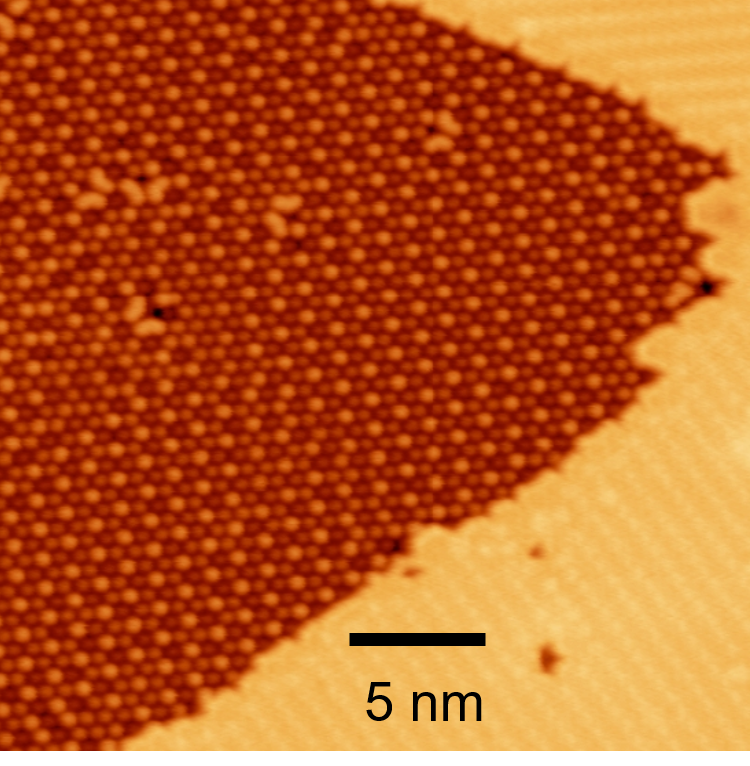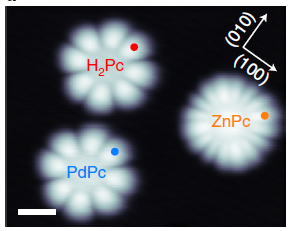
Presentation
The main mission of the GdR NS-CPU is to bring together the French community whose "nanoscience" research activities are based on scanning probe microscopy (SPM) techniques operating under ultra high vacuum (UHV).
Coordinators: David MARTROU (CEMES), Jérôme LAGOUTE (MPQ)
Assistant coordinators: Clemens BARTH (CINaM), Christophe BRUN (INSP), Yannick DAPPE (SPEC, CEA), Sylvie GODEY (IEMN), Christian JOACHIM (CEMES), Guillaume SCHULL (IPCMS), Loranne VERNISSE (Pprime)
5 Research Areas

Electronic and vibrational structure of individual nanostructures and nano-objects

Nanometer-scale light-matter interactions

Study of local magnetism and quantum states

Electronic properties, electrostatic properties and charge transfer

Theoretical concepts and computational tools
Prospectives
Backed by surface sciences, nanosciences intersect many scientific and technical fields: nanoelectronics, electronics and molecular mechanics, nanomagnetism, the physics of semiconductors and superconductors, the physics and chemistry of individual nano-objects, heterogeneous catalysis, metallurgy ...
The instruments of choice for the study of nanosciences are near-field microscopies (STM, STM-photon, STM + magnetic field, STS, NC-AFM, KPFM) operating under ultra-vacuum (UHV), and at different temperatures (4 K , 77 K, 300 K,…). They provide direct access to the topography of the support surface, but above all to the electronic, optical or magnetic properties of a single nano-object, a molecule, an atom or a surface state.
Electronic and vibrational structure
Tunnel spectroscopy (STS) provides access to the electronic structure of matter down to the atomic scale through I (V), I (Z) and differential conductance measurements. This technique allows to measure the electronic spectrum of individual nano-objects (a molecule, a nanostructure), and also to probe the electronic properties of low-dimensional materials (nanotubes, graphene and other two-dimensional materials). Vibrational states can be probed by inelastic spectroscopy both on an individual nano-object and on nanomaterials.
Light-matter interactions
The optical properties of a single nano-object, such as a quantum dot, a fluorescent molecule or an atom, critically depend on their interactions with their nearby environment (<10 nm). Various mechanisms such as a transfer of charge or energy between the tip and the nano-object can be used to probe, modify or exacerbate the properties of these nano-objects. Experiments combining, under ultra-vacuum, tunneling and optical microscopies, allow direct observation of these mechanisms. The development of approaches combining STM and pulsed lasers opens a path towards pump-probe experiments combining atomic-scale spatial resolution and femtosecond time resolution.
Local magnetism and quantum states
The study of the electronic properties of bulk materials, low-dimensional materials or individual nano-objects presenting a non-trivial quantum state (magnetic, superconducting, charge- or spin-density-wave, Mott insulator, topological insulator or topological superconductor, etc.) has grown significantly with the development of (very) low temperature UHV STM techniques, including those coupled to an external magnetic field. These techniques enable observing the quantum order parameters, the charge or spin local orders at the atomic scale. Recent instrumental developments aim at probing time-resolved and/or frequency-resolved (up to few dozens of GHz) elementary electronic excitations.
Electrostatic and charge transfer
The study of electrostatic phenomena at the elementary charge scale is observed in non-contact mode atomic force microscopy (nc-AFM) coupled with Kelvin probe microscopy (KPFM). We measure both the topography with atomic resolution and the surface potential linked to the electrostatic (dipoles, charges) and electronic (work function, doping, etc.) properties of the surface or of the single nano-object studied (a nanoparticle, a nano-island, a molecule, an atom, surface defects, etc.).
Theoretical concepts and computational tools
The description of the “tip-surface” interactions (alone or with the nano-object) such as exchange, electrostatic, Van der Waals and magnetic,… is the basis of all the calculations making it possible to predict and reproduce the different experiments that can be carried out in the near field: topography (STM, NC-AFM), dnI / dVn, dI / dZ, dZ / dV (STS), ∆f / dZ, ∆f / dV (NC-AFM / KPFM) spectroscopies, atomic or molecular manipulations. The interpretation of the experimental data will support the development and provision of calculation codes based on the quantum and / or semi-classical description of these interactions.nI/dVn, dI/dZ, dZ/dV (STS), ∆f/dZ, ∆f/dV (NC-AFM / KPFM), manipulation d’un atome ou d’une molécule. L’interprétation des données expérimentales va appuyer le développement et la mise à disposition de codes de calculs basés sur la description quantique et/ou semi-classique de ces interactions.














